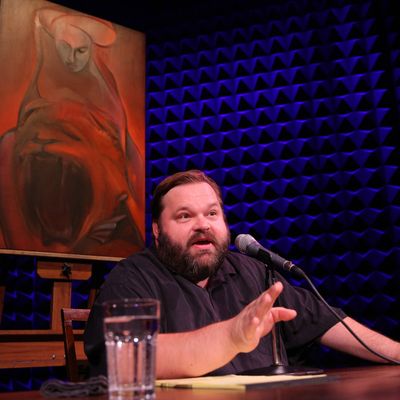
“Lie to us!” my seatmate whispered as the man of the hour took his seat. Up came the Fresnels, down came the hands, and Mike Daisey proceeded to do just that. It was just like old times. Well, not exactly like old times. Daisey, as Daisey points out early and often, has been through some rough chop. His last show, The Agony and Ecstasy of Steve Jobs, was promoted as groundbreaking theatrical “journalism,” then demoted to mere fraud in a matter of weeks (and over the course of a single, harrowing “This American Life” episode). Afterwards, he was lost, and even considered taking his own life.
Doubt that last bit? You’re invited to: It’s what kicks off Daisey’s new show, All the Faces of the Moon, a 29-part, 44-hour, monthlong epic about fiction, fantasy, magic, and, yes. lying. But All the Faces is, above all, about Mike Daisey, famous monologist, flawed, intermittently suicidal fabulist-polemicist — the semi-invented character who’s succeeded Steve Jobs, Jeff Bezos, and late-capitalism as Mike Daisey’s idée fixe. Your response to this ambient incantation, which can bewitch, bewilder, and, yes, also bore, in the weird fermatas between solid laughs and serious insights, will vary in relation to your affection for this character.
The show is billed as a “theatrical novel” about New York City, in all its duality: real and mythic, “old” and “new,” pre-9/11 and post-, the city of the almighty dollar and the city of the almighty imagination. The nightly chapters, each inspired by a tarot card and accompanied by a painting by Larissa Tokmakova, are meant to stand alone, with an epic arc overspanning them like the Brooklyn Bridge. This would be a tall order for a garden-variety printed novel, much less a “theatrical” one, and I can’t comment on Daisey’s success or failure in that larger goal — because, like most partially employed lifeforms, I can’t attend all 29 shows. I can tell you that Daisey, his clean-shaven Metatron-of-the–Big Idea persona traded for a brambly beard, his neatly stacked outlines switched for a rambling, more clearly improvised tone, hasn’t lost his power to bewitch, but he has lost (or perhaps simply put aside) his fierce, focused message and the discipline that shaped it into a performative weapon. This show seems to be about finding a new message, a new raison, which means a Bloomsday’s worth of flaneuring, a lot of mystic hidden-world Pynchoneering, and a wholesale retreat into the twinkly hermeneutics of nostalgia. (This, in general, is what we secular humanists do in lieu of Jesus after the shit’s come down.)
I saw Moons Three (“The Magician and the Fish”) and Seven (“The Naked Emperor is Still Laughing”), where Daisey’s subjects ranged from a bleak childhood spent learning Elvish and playing Dungeons & Dragons in frigid northern Maine to the historical pinchpoint of September 11 and the ebbing power of the New York Times. (You’ve got to respect the balls: Daisey flicks at Jayson Blair without batting an eyelash.) In an author’s note, Daisey compares his technique to Tokmakova’s oils, where layer after layer eventually reveals the image.
A more apt metaphor, I think, is the scattered apparatus of role-playing games: a table littered with dice, graph paper, and various talismans of fantasy. Look at all the names! It’s a Silmarillion’s worth: Twenty-nine separately titled nights, an array of recurring characters (a pansexual libertine, an incarnation of Dionysius, an angry high-school gaming buddy with busted knuckles), a podcast series entitled, teasingly, “All Stories are Fiction.” Names, titles, endless marathon unspoolings that promise some eventual convergence, even as the threads float apart — these are the marks of fantasy. I thought of something Thomas Mallon once wrote about Atlas Shrugged: “The book could never, in fact, have been any shorter, because it needed to feel like a whole substitute world, a full-blown reassuring place — you’re right, they’re wrong; you’re special, they’re not — into which the discoverer can jump, as into a magic wardrobe, and then live, happily, airlessly, for weeks of reading and rereading.” It’s not a matter of whether Daisey’s trading quality for quantity: With this show, as with every fantasy, the quantity is the quality.
Daisey’s ideas, comic set pieces, and narrative figures may lack his usual tautness, but he’s still capable of great lyricism (as when he calls rural places “filthy with moments that hang forever,” irritating motion-mad New Yorkers) and gorgeous imagery (fish sealed alive beneath ice, gaping up at passersby; a Red Hook tableau frozen in time, as death glides across the river). But it’s a stretch to say his nightly chapters “stand alone”; they’re all digression, with Lost-like cliff-hangers to tailhook them. And his insights into gentrification and aging out of New York City — which, beyond therapy, appear to be the show’s raisons d’etre — feel both a little reheated and lot retreated-from. (I lost count of how many times he walked back a point.) That’s all part of living in the perpetual Daiseydammerung. You’re either the sort of person who pays a palmist to lie to you or the sort who doesn’t. And if you’re the former, what’s a little shag and repetition matter? It’s magic hour. Twenty-nine times over.
All the Faces of the Moon plays through October 3 at Joe’s Pub at the Public Theater.




